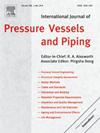基于应变的选择性焊缝腐蚀管道破裂压力建模
IF 3
2区 工程技术
Q2 ENGINEERING, MECHANICAL
International Journal of Pressure Vessels and Piping
Pub Date : 2025-05-17
DOI:10.1016/j.ijpvp.2025.105558
引用次数: 0
摘要
本研究开发了一种数据驱动的建模方法,用于估计由选择性焊缝腐蚀(SSWC)引起的表面楔形缺陷管道的破裂压力。通过对不同管道属性进行有限元分析,建立了基于SSWC的管道破裂压力模型。利用Buckingham π定理对每个管道属性进行参数化研究,并通过将极限三轴应变准则应用于有限元应力和应变结果得出破裂压力估计。将模型预测结果与行业中使用的标准方法的失效压力估计结果进行了比较。该研究的一个关键发现是将缺陷顶点半径纳入数据驱动的破裂压力模型中至关重要。通过灵敏度分析来评估顶点半径估计的不准确性对预测破裂压力的影响,并提出了一种利用可测量缺陷参数估计顶点半径的参数化方法。进行了全尺寸静水破裂压力试验,并与有限元预测结果进行了对比,验证了三维有限元模型和管道破坏极限三轴应变准则的准确性。本文章由计算机程序翻译,如有差异,请以英文原文为准。
Strain-based modeling of burst pressure in pipelines with selective seam weld corrosion
A data-driven modeling process has been developed in this study to estimate the burst pressure of pipelines with surface wedge-shaped defects caused by selective seam weld corrosion (SSWC). The modeling of the pipeline burst pressure with SSWC was formulated through finite element analysis (FEA) conducted for different pipe attributes. Parametric studies for each pipe attribute were framed using the Buckingham π theorem, with burst pressure estimates derived by applying the Limiting Triaxial Strain criterion to the FEA stress and strain results. The model predictions were compared to failure pressure estimation results from standard methods used in the industry. A key finding from this research is the critical importance of incorporating the defect vertex radius into the data-driven burst pressure models. A sensitivity analysis was performed to assess how inaccuracies in vertex radius estimation affect predicted burst pressure, and a parametric method has been proposed to estimate the vertex radius using measurable defect parameters. Full-scale hydrostatic burst pressure tests were conducted and compared to the FEA predictions to validate the accuracy of the 3D FEA models and the limiting triaxial strain criterion of pipe failure.
求助全文
通过发布文献求助,成功后即可免费获取论文全文。
去求助
来源期刊
CiteScore
5.30
自引率
13.30%
发文量
208
审稿时长
17 months
期刊介绍:
Pressure vessel engineering technology is of importance in many branches of industry. This journal publishes the latest research results and related information on all its associated aspects, with particular emphasis on the structural integrity assessment, maintenance and life extension of pressurised process engineering plants.
The anticipated coverage of the International Journal of Pressure Vessels and Piping ranges from simple mass-produced pressure vessels to large custom-built vessels and tanks. Pressure vessels technology is a developing field, and contributions on the following topics will therefore be welcome:
• Pressure vessel engineering
• Structural integrity assessment
• Design methods
• Codes and standards
• Fabrication and welding
• Materials properties requirements
• Inspection and quality management
• Maintenance and life extension
• Ageing and environmental effects
• Life management
Of particular importance are papers covering aspects of significant practical application which could lead to major improvements in economy, reliability and useful life. While most accepted papers represent the results of original applied research, critical reviews of topical interest by world-leading experts will also appear from time to time.
International Journal of Pressure Vessels and Piping is indispensable reading for engineering professionals involved in the energy, petrochemicals, process plant, transport, aerospace and related industries; for manufacturers of pressure vessels and ancillary equipment; and for academics pursuing research in these areas.

 求助内容:
求助内容: 应助结果提醒方式:
应助结果提醒方式:


